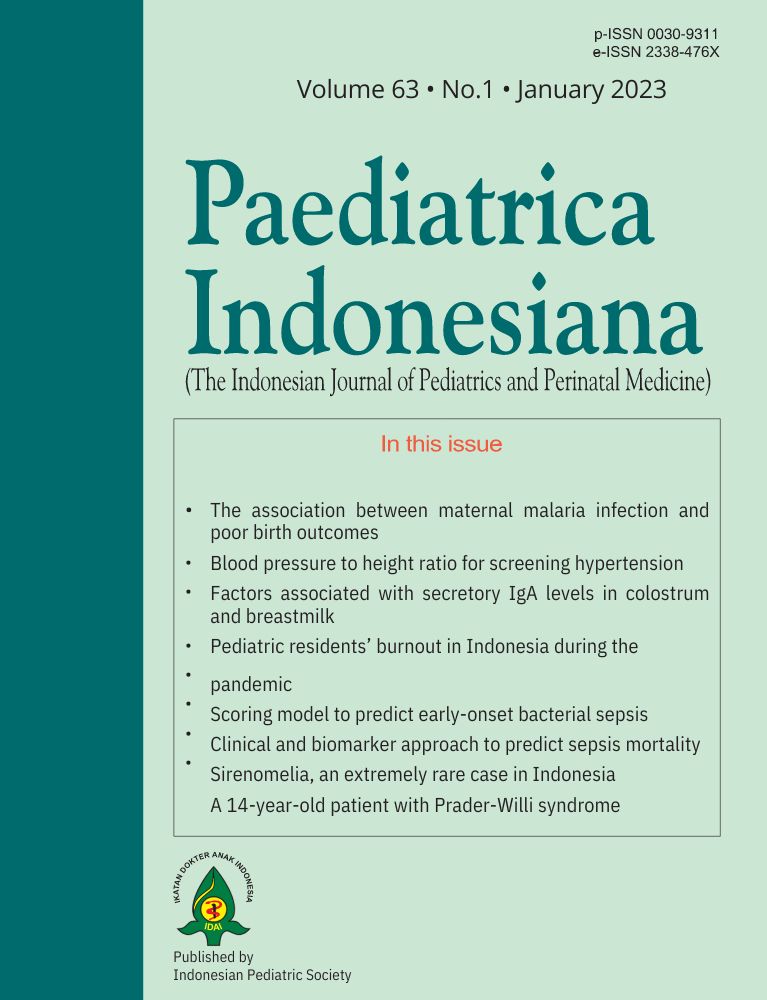Scoring model to predict early-onset bacterial sepsis at Dr. Mohammad Hoesin Hospital, Palembang
DOI:
https://doi.org/10.14238/pi63.1.2023.29-36Keywords:
early-onset neonatal sepsis; scoring systemAbstract
Background Early-onset bacterial neonatal sepsis (bacterial EONS) is one of the most common causes of death and illness in newborns. Assessment of risk factors is important to identify infants who are more susceptible to bacterial EONS. A scoring model based on maternal and infant risk factors would be useful for predicting bacterial EONS.
Objective To develop a scoring model to predict bacterial EONS by examining maternal and neonatal risk factors.
Methods This diagnostic test study was conducted at Mohammad Hoesin Hospital, Palembang between January-September 2021 using various maternal and infant risk factors. Subjects were newborns suspected of having early-onset bacterial sepsis with birth weight >1000 grams. The potential risk factors evaluated consisted of premature rupture of membranes >18 hours, greenish-thick-and-foul-smelling amniotic fluid, maternal body temperature >38°C, maternal leukocytosis >15.000/?L, gestational of <37 weeks, birth weight of <2500 grams, and APGAR score of <7 at 1 minute. One hundred sixty-two subjects were selected consecutively. Analyses included odds ratio, logistic regression test, and ROC curve to assess sensitivity and specificity of each risk factor.
Results Premature rupture of membranes >18 hours, greenish-thick-and-foul-smelling amniotic fluid, male sex, and gestation of <37 weeks were risk factors for bacterial EONS. In the multivariate analysis, premature rupture of membranes >18 hours had an OR of 5.94 (95%CI 1.69 to 20.86, P=0.005), greenish-thick-and-foul-smelling amniotic fluid had an OR of 3.74(95%CI 1.16 to 12.02, P=0,027), male sex had an OR of 4.28 (95%CI 1.14 to 16.02, P=0.031), and gestation of <37 weeks had an OR of 3.1 (95%CI 0.82 to 11.72, P=0.094). In the scoring model, each of these four risk factors were assigned a score of 2 (for maternal risk factors) and 1 (for neonatal risk factors). Using a cut-off score of 2.5 to predict bacterial EONS, the scoring system had a sensitivity of 80% and specificity of 47%.
Conclusion Our scoring model of maternal and infant risk factors can be used to screen for possible bacterial EONS at an earlier stage of illness, although with limited specificity.
References
2. Gomella T, Cunningham M, Eyal FG, Tuttle DJ. Sepsis. In: Gomella T, Cunningham M, Eyal FG, Tuttle DJ, editors. Neonatology: Management, procedures, on-call problems, diseases, and drugs. 7th edition. New York: McGraw Hill; 2013. p. 865-70.
3. Ferrieri P, Wallen DL. Neonatal bacterial sepsis. In: Gleason AC, Devaskar US, editors. Avery’s diseases of the newborn. 9th ed. Philadelphia: Elsevier; 2012. p. 538-50.
4. Garg S, Tin W. Remington and Klein’s infectious diseases of the fetus and newborn Infant. Semin Fetal Neonatal Med. 2015;20:442-44.
5. Camacho-Gonzalez A, Spearman PW, Stoll BJ. Neonatal infectious diseases: evaluation of neonatal sepsis. Pediatr Clin North Am. 2013;60:367-89. DOI: https://doi.org/10.1016/j.pcl.2012.12.003.
6. Takkar VP, Bhakoo ON, Narang A. Scoring system for the prediction of early neonatal infections. Indian Pediatr. 1974;11:597-600. PMID: 4443063.
7. Rodwell RL, Leslie AL, Tudehope DI. Early diagnosis of neonatal sepsis using a hematologic scoring system. J Pediatr. 1988;112:761-7. DOI: https://doi.org/10.1016/s0022-3476(88)80699-1
8. Spector SA, Ticknor W, Grossman M. Study of the usefulness of clinical and hematologic findings in the diagnosis of neonatal bacterial infections. Clin Pediatr. 1981;20:385-92. DOI: https://doi.org/10.1177/000992288102000602.
9. Giannoni E, Agyeman PK, Stocker M, Posfay-Barbe KM, Heininger U, Spycher BD, et al. Neonatal sepsis of early onset, and hospital-acquired and community-acquired late onset: a prospective population-based cohort study. J Pediatr. 2018;201:106-14. DOI: https://doi.org/10.1016/j.jpeds.2018.05.048.
10. Agyeman PKA, Schlapbach LJ, Giannoni E, Stocker M, Posfay-Barbe KM, Heininger U, et al. Epidemiology of blood culture-proven bacterial sepsis in children in Switzerland: a population-based cohort study. Lancet Child Adolesc Health. 2017;1:124-33. DOI: https://doi.org/10.1016/S2352-4642(17)30010-X.
11. Moges F, G. Eyesus T, Eshetie S, Yeshitela B, Abate E. Bacterial etiologic agents causing neonatal sepsis and associated risk factors in Gondar, Northwest Ethiopia. BMC Pediatr. 2017;17:137. DOI: https://doi.org/10.1186/s12887-017-0892-y.
12. Sorsa A. Epidemiology of neonatal sepsis and associated factors implicated: observational study at neonatal intensive care unit of Arsi University Teaching and Referral Hospital, South East Ethiopia. Ethiop J Health Dev. 2019;29:333-42. DOI: https://doi.org/ 10.4314/ejhs.v29i3.5.
13. Murthy S, Godinho MA, Guddattu V, Lewis LES, Nair NS. Risk factors of neonatal sepsis in India: a systematic review and meta-analysis. PloS One. 2019;14:e0215683. DOI: https://doi.org/10.1371/journal.pone.0215683.
14. Gandra S, Ranga SK, Hendrixson DT, Nayakanti RR, Newland JG, Alvarez-Uria G, et al. Association of intrapartum risk factors and infant clinical indicators with culture confirmed early onset neonatal sepsis in a secondary care rural hospital in India. J Trop Pediatr. 2021;67:fmaa061. DOI: https://doi.org/10.1093/tropej/fmaa061.
15. Masanja PP, Kibusi SM, Mkhoi ML. Predictors of early onset neonatal sepsis among neonates in Dodoma, Tanzania: a case control study. J Trop Pediatr. 2020;66:257-66. DOI: https://doi.org/10.1093/tropej/fmz062.
16. Goel N, Shrestha S, Smith R, Mehta A, Ketty M, Muxworthy H, et al. Screening for early onset neonatal sepsis: NICE guidance-based practice versus projected application of the Kaiser Permanente sepsis risk calculator in the UK population. Arch Dis Child Fetal Neonatal Ed. 2020;105:118-22.
17. Benitz WE, Achten NB. Technical assessment of the neonatal early-onset sepsis risk calculator. Lancet Infect Dis. 2021;21:134-40. DOI: https://doi.org/10.1016/S1473-3099(20)30490-4
18. Husada D, Chanthavanich P, Chotigeat U, Sunttarattiwong P, Sirivichayakul C, Pengsaa K, et al. Predictive model for bacterial late-onset neonatal sepsis in a tertiary care hospital in Thailand. BMC Infect Dis. 2020;20:151.
Downloads
Published
How to Cite
Issue
Section
License
Authors who publish with this journal agree to the following terms:
Authors retain copyright and grant the journal right of first publication with the work simultaneously licensed under a Creative Commons Attribution License that allows others to share the work with an acknowledgement of the work's authorship and initial publication in this journal.
Authors are able to enter into separate, additional contractual arrangements for the non-exclusive distribution of the journal's published version of the work (e.g., post it to an institutional repository or publish it in a book), with an acknowledgement of its initial publication in this journal.
Accepted 2023-03-02
Published 2023-03-10














